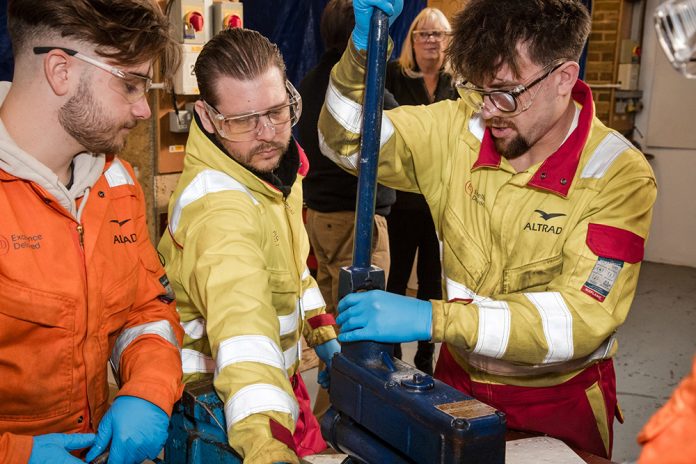With record levels of investment driving growth and increasing demand for skilled workers, the need for skills and training in the UK water industry has never been greater.
In December, regulator Ofwat confirmed it would allow water companies in England and Wales to invest a record-breaking £104 billion over the next five years for the eighth asset management period (AMP8). This is designed to accelerate delivery of cleaner rivers and seas and secure long-term drinking water supplies for customers.
As an industry-led skills body, our role at the Engineering Construction Industry Training Board (ECITB) is to help build the skilled workforces needed to meet current and future demand.
For context, the engineering construction industry (ECI) is a specialised industry that underpins the delivery, maintenance and decommissioning of some of the UK’s most important infrastructure.
Our employers work in renewables, nuclear, oil & gas, hydrogen and carbon capture, as well as other major process industries including chemicals, pharmaceuticals, food processing and the water sector.
It is only sewerage processing and water treatment activities within the scope of our work at the ECITB. However, our latest labour market intelligence for the water treatment sector still paints a stark picture of the scale of the challenges facing the industry as a whole, especially when you consider the extra demands there will also be from water distribution.
The ECITB’s Labour Forecasting Tool (LFT) highlights that the size of the ECI workforce in the water treatment sector could increase by 48% to total more than 4,300 by 2030.
Bringing in new talent, reskilling workers from other sectors, as well as training and upskilling existing workers, is vital to secure the skilled workforce the water sector will need in the next five years.
Understanding skills needs
This need to plug labour shortages is why skills are at the core of everything we do at the ECITB. It’s why we invest in training – over £29 million in 2024 alone – to help people gain skills and qualifications and create clear career pathways.
We’re not just focused on training and development though, but also on understanding where the skills needs are and how they are changing. We gather critical workforce intelligence to help employers and the industry plan for the future.
Central to this effort is the ECITB Workforce Census, which we conduct every three years and which provides a comprehensive snapshot of the industry and its workforces.
Our latest Census, which gathered data in May-June 2024, showcased specific characteristics and challenges in the water and waste treatment sector within the ECI.
The Census gathered data on 2,700 workers in the water treatment sector, with additional data on regional differences, demographic trends, hiring challenges and business opportunities.
It revealed that a third of workers in the sector are over 50, suggesting a need to recruit younger workers.
The cyclical nature of the work in the water sector means demand for skills and workers fluctuates heavily. This unpredictability not only impacts workforce efficiency and drives up costs, but also makes careers in the sector less appealing to new entrants.
In the report, water sector employers who said they have experienced difficulties filling vacancies cited both a lack of skilled candidates and limits on their ability to offer competitive pay as reasons.
Occupations such as pipefitters, welders, electricians, instrumentation and control technicians, site managers and design engineers were frequently mentioned as difficult to recruit.
Our recent LFT predictions also highlight that design technicians, project managers and mechanical fitters are set to be among the roles most in demand in the next five years.
Finding these extra workers won’t be a straightforward task when you consider that our 2024 career motivations study showed the water sector is struggling to appeal to workers. This was particularly the case for women, who currently make up 20% of the workforce.
When asked whether they would consider a career in the water sector, just 24% of workers and learners already in the ECI said yes, the lowest score of any sector across engineering construction. This figure was lower still at 18% for people in the wider population and only 14% for women.
The way forward
At Utilities Live in May, I spoke about what needs to be done to prepare the future workforce amid the challenges facing the water sector.
There is real pressure on the water industry to respond to climate-related challenges, like flooding and droughts, while population growth, especially in south-east England, is making water scarcity worse.
Increasing water storage infrastructure, such as reservoirs, is becoming critical to ensure supply in the industry. At the same time, the industry is busy working towards decarbonisation and net zero targets.
This all requires a laser-focused mission to attract, train, upskill and reskill large numbers of new and existing workers.
Part of the problem is that employers and the supply chain in the water sector are competing for the same talent as many adjacent sectors, placing pressure on traditional recruitment and workforce strategies.
It is vital to invest in talent ahead of project need. Training lead times can be long and so developers and asset owners should prioritise supply chain and skills planning.
Upskilling and reskilling the existing workforce will be critical. It will help workers acquire additional skill sets on top of core discipline-specific competencies, for example, welding skills to a qualified pipefitter. This will improve worker mobility and enhance skills transferability.
Our Connected Competence scheme is a good example of transferability in practice. It’s already in place in the oil and gas sector, where it now covers around 75% of the workforce. This scheme offers standardised technical testing to verify base-level competence that is then recognised by different employers, thereby helping workers move easily between projects.
Of course, workforce mobility is especially important in sectors like water, where demand is cyclical. We could, for example, see water workers move into projects in food and drink or renewables and then back into water again when labour demand peaks.
The ECITB recognises the need for new approaches to training delivery and assessment, such as modular and blended learning, pre-apprenticeships, alongside traditional pathways and investment in training facilities and resources.
We’re already taking steps in these areas through our ECITB new entrant programmes, support for employer training and by funding Regional Skills Hubs to boost training provider capacity and grow new entrant numbers in industrial cluster hot spots.
But this is a task that goes beyond just one organisation. It’s a job for the entire industry to be involved in.
Collaboration is key – between asset owners, clients, contractors, training providers, government departments, the ITBs and other government agencies – to help address skills shortages in the water sector. This includes cross-sectoral collaboration to help plan future workforce skills needs.
Find out more about the ECITB at
www.ecitb.org.uk




